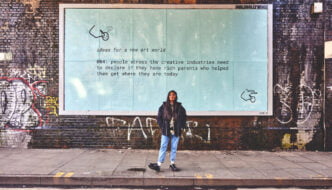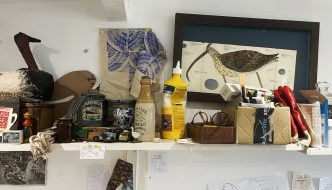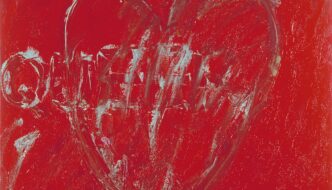Lorna Johnson is an artist working across a range of materials to make sculptural objects, installations, assemblages, collage and photography. She is drawn to objects and materials that could be perceived as non-precious and uses these to explore the associations people may have with these as materials and as objects. These themes are central to the research she is currently doing towards a practice-led PhD at Leeds University.
Court Spencer caught up with her at Patrick Studios to find out more about her work and current projects.
Lorna Johnson in her studio. Credit: Court Spencer
Court: Thanks for having me over, and on a Sunday morning… that’s dedication! Do you want to begin by introducing your practice?
Lorna: No problem, thanks for coming! So I would say I’m a maker of things – at my core it’s all about objects, making, finding, placing or combining objects. My instinct is to cherry-pick and I see this as part of my role as an artist. I’m drawn to objects and materials where the monetary value is questionable – these could be perceived as disposable or non-precious. I explore this visually through the combinations of materials and the quantities I choose to use, and as you said, the associations people may have with both material and object.
Court: What were you like as a little kid? Did you like collecting things? Were you a bit of a maker even back then?
Lorna: Yes! I definitely liked collecting things from a bottom desk draw full of conkers and acorns to anything shiny and gem like. It’s a habit I don’t think I’m any closer to shaking off! I was attracted to combinations of colours which made me feel good and things I could line up – haha…. a lot like my work today! I liked to construct things out of paper, cardboard and tape – a lot of tape!
Small artist made objects. Credit: Court Spencer.
Court: Materials and the history and associations with those materials feel like they’re important. Are there reoccurring materials you use that have particular significance?
Lorna: Yes, that’s really important to the items that I make and my thought process. I like my materials to have substance, something of a life force. I definitely see the materials as ingredients that I bring together to make the piece – all are needed and all bring their own individuality.
As to reoccurring materials, I like working with string, raffia, thread, stone, wood and shells. I feel these work hand in hand with the reoccurring methods I use, whether this be sewing, plaiting, knitting, sanding, collaging or placement. I like materials that feel basic but are open to possibility. Through repeat use, my knowledge of these increases and they provide a familiar foundation that gives me a solid foundation to work from and the confidence to introduce new materials.
I also like materials I can get loads of! I can then go through a process of sifting through which of these materials makes the cut. It’s important to me that the viewer can identify the materials used and tap into how these materials make them feel, and possibly think about their own relationships or memories with these materials they have or may have had in their lifetime. For example, the small wooden forks you get from a fish and chip shop, wood chips, kindling, muscle shells etc.
Court: A lot of the materials have a connection to your childhood to some extent, for example, the mustard velvet curtains you used in a piece you showed at Fountains Abbey and Studley Royal. Can you talk us through this piece and the process you took?
Lorna: It might be the case that I come across the material or object by chance and then it feels right to use in a piece as with Fabric offering – Heirlooms. With this piece, I put the mustard velvet material through quite a therapeutic process of cutting, unstitching, washing, ironing and folding. It felt right to spend time with this material and get it into the best condition that it could be after it’s long time serving as curtains. The piece was then brought together through patch working, beading and pinning.
The materials or objects are generally ones which I feel deserve a new lease of life and to make it out of my grandmother’s back bedroom. The objects chosen have a certain charm for me and my grandmother’s curtains are an ever present visual memory when I think about my grandparent home. I also think I quite like putting some of these ‘real’ items into the mix just for me, even if I don’t talk about their personal connection to my childhood – they are my secret within a piece, a hidden backbone to the narrative I give the work.
Scent Placement and other artist made objects. Credit: Court Spencer.
Court: I love these (points to the clay pieces cushioned and partially wrapped in fabric with beaded trim). What are they?
Lorna: Thank you! This piece is called Scent Placement, these are cushion covers from my childhood and I’ve beaded the frills with red glass beads. It felt important to bead the part of them that was probably responsible for making them redundant and consigned to the back bedroom! No longer fashionable the frill is now the part that is adorned. As a duo the covers nestle a stone and a clay scent holder pot. I’ve played with the concept of adding scent to my pieces for a while and this was one of the first pieces where I have made a structure for fragrant herbs to be very much a visual part of the piece.
Lorna Johnson’s studio. Credit: Court Spencer.
Court: So you’ve got this studio but you also work from home. Do you use the spaces for different purposes?
Lorna: Doing the practice-led PhD led me to needing a work space at home, which also came in quite handy when Covid entered our lives. The room I have at home only really lends itself to working with relatively clean materials that I don’t mind using in a domestic environment. Making An Agreeable Space has worked really well because hand sewing has been the dominant method for the piece which is made up of 143 lavender scented pew cushions. These will be placed with over 600 pale blue candles at Holy Trinity Church, Goodramgate, York in September 2021.
Lorna Johnson installing An Agreeable Space in York. Credit: JoJo Stott (www.jojostott.com)
Court: That sounds like a huge sewing project. Can you talk a little more about An Agreeable Space and how the project came about and your plans for it?
Lorna: In 2019 I approached the church and they kindly said yes to my proposal! I was interested in the church’s female history and wanted to make a piece that celebrated the female presence the church had held over the centuries. There was limited specific information about the families who attended the church so I found the last congregation numbers recorded and halved it. This number, 143 would represent the female presence within the church and is the number of cushions I made.
These contain Yorkshire lavender, which when sat on, release the scent – denoting the women who have passed through this space over the years and filling the air with their fragrance. I like that over time the cushions might get worn and dirty, much the same as a Sunday dress. The hand sewn adornments use a variety of fabrics representing a cross section of society, and represent this coming together and speaks of the interdependency of these women with one another in society and the possible changing fortunes of women throughout their descendant’s lifetimes. Ultimately this place – Holy Trinity Church, Goodramgate, allowed the women within these walls to sit still, rest the fabric that would have weighed upon them, take in the space and what it offered them.
Following on from this installation, I would love the piece to tour, giving it a longevity I believe is important for all artwork. By putting the piece into different spaces, the artwork can evolve, reach different audiences and challenge itself.
Court: I think that’s a great point about touring and taking your work to different audiences rather than feeling the need to make new work for each exhibition. What are some of the stand out exhibitions you’ve been part of?
Lorna: The Arts Council funded research project – Curio•sea•ty, I did with Hondartza Fraga was fantastic because we got to travel to different museums and archives in the UK and USA. This was such a great thing to be able to do, to give your work the thinking time that is so often the part which feels rushed and the first thing you cut when working to a deadline. The exhibition we put on at East Street Arts’ Project Space in Leeds in 2015 was great to show work which was fully made and work that was still in progress. It really felt like an exhibition conducted with real thinking time.
The St Margaret of Antioch Exhibition at Left Bank Leeds in 2018 was also a great exhibition to be part of. It allowed me to explore new processes and methods which I hadn’t used before and to bring together scent and taste into a piece for the public which was a first for me. Definitely a forerunner for me in scent thinking for An Agreeable Space.
And finally I think, my transfer exhibition To earmark in 2019 at the Project Space at the School of Fine Art, Art History, Cultural Studies at Leeds University, was one of the first exhibitions where I have been able to show a larger body of work together. That felt like a real luxury, to be able to see how your current work sits together in one space – magic!
Court: And if you could make any project happen, what would your dream project be?
Lorna: That’s a really hard one! I love a bit of detective work, aka research! I suppose it would be for an archive or heritage site to give me open reign in their records and archives. Not really knowing what I was going to find, that would be of interest. I like descriptions of objects that once existed that you now have to imagine as well as objects that have made it through time to be with us today. I like learning about the facts and narratives of the people that once lived or worked in a place. So for me a dream project would be a bit of matching pairs game – matching people to objects, objects to people, people to people and objects to objects. I love learning about all the connections, connecting the dots! I like objects that have a real personal attachment to a person that took care of it, love it, wanted it. Something everyday that lived with the person on a daily basis the objects that get the ware and tear of everyday life but are loved because they come along for the ride regardless.
Also more scent! Something that involves researching and recreating a scent would be amazing! I would love to work with a site or a place that is rich in a scent history, to create a work that could evoke a scent feeling, remembering. In essence for me, having access to archives or heritage sites that want to work with an artist to create a piece of work in response to their history is a golden invitation I can never refuse.
Court: So, you’ve got An Agreeable Space on at Holy Trinity Church, Goodramgate in York, 1-18 Sept. How can people keep up to date with your work and exhibitions?
Lorna: Via my Instagram – @lornamilnerjohnson and Twitter – @lornamjohnson accounts and my website – lornamilnerjohnson.com
Filed under: Art & Photography
Tagged with: an agreeable space, art, art and photography, cloth, East Street Arts, embroidery, exhibiton, gallery, history, knitting, Leeds art, Leeds arts university, lorna johnson, making, materials, objects, textiles



Comments